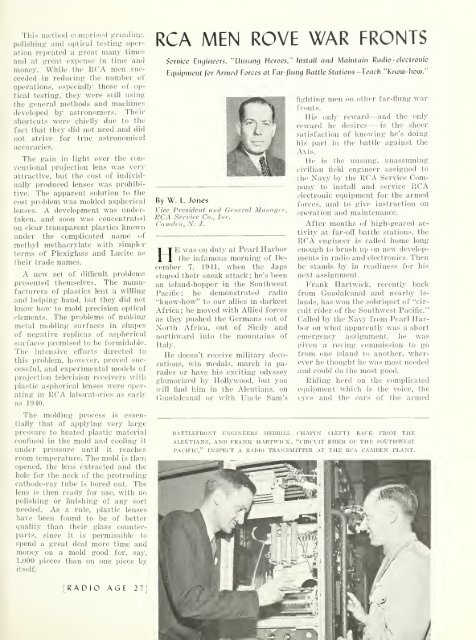Radio Age - 1944, January - 36 Pages, 3.3 MB ... - VacuumTubeEra
Radio Age - 1944, January - 36 Pages, 3.3 MB ... - VacuumTubeEra
Radio Age - 1944, January - 36 Pages, 3.3 MB ... - VacuumTubeEra
Create successful ePaper yourself
Turn your PDF publications into a flip-book with our unique Google optimized e-Paper software.
This method L-cmpi'ised KriiuliiiK.<br />
polishing and optical testing operation<br />
repeated a great many times<br />
and at great expense in time and<br />
money. While the RCA men succeeded<br />
in reducing the number of<br />
operations, especially those of optical<br />
testing, they were still using<br />
the general methods and machines<br />
developed by astronomers. Their<br />
shortcuts were chiefly due to the<br />
fact that they did not need and did<br />
not strive for true astronomical<br />
accuracies.<br />
The gain in light over the conventional<br />
projection lens was very<br />
attractive, but the cost of individually<br />
produced lenses was prohibitive.<br />
The apparent solution to the<br />
cost problem was molded aspherical<br />
lenses. A development was undertaken,<br />
and soon was concentrated<br />
on clear transparent plastics known<br />
under the complicated name of<br />
methyl methacrylate with simpler<br />
terms of Plexiglass and Lucite as<br />
their trade names.<br />
A new set of difficult problems<br />
presented themselves. The manufacturers<br />
of plastics lent a willing<br />
and helping hand, but they did not<br />
know how to mold precision optical<br />
elements. The problems of making<br />
metal molding surfaces in shapes<br />
of negative replicas of aspherical<br />
surfaces promised to be formidable.<br />
The intensive efforts directed to<br />
this problem, however, proved successful,<br />
and experimental models of<br />
pro.iection television receivers with<br />
plastic aspherical lenses were operating<br />
in RCA laboratories as early<br />
as 1940.<br />
The molding process is essentiall.v<br />
that of applying very large<br />
jiressure to heated plastic material<br />
confined in the mold and cooling it<br />
under pressure until it reaches<br />
room temperature. The mold is then<br />
opened, the lens extracted and the<br />
hole for the neck of the protruding<br />
cathode-ray tube is bored out. The<br />
lens is then ready for use, with no<br />
polishing or finishing of any sort<br />
needed. As a rule, plastic lenses<br />
have been found to be of better<br />
quality than their glass counterparts,<br />
since it is permissible to<br />
spend a great deal more time and<br />
money on a mold good for, say,<br />
1,000 pieces than on one piece by<br />
itself.<br />
RCA MEN ROVE WAR FRONTS<br />
Seruice Eiuvneen. "Liiisiint Heroes," Insfull and Maintain Rodio- electronic<br />
Equipment for Armed Forces at Far-flumj BtUlleStiniotis-Teach "Knoio-hoiu."<br />
By W. L Jones<br />
'i'ice<br />
President and General Manager,<br />
RCA Service Co., Inc.<br />
Camden, N. J.<br />
HE<br />
was on duty at Pearl Harbor<br />
the infamous morning of Deceml)er<br />
7, 1941, when the Japs<br />
staged their sneak attack; he's been<br />
an island-hopper in the Southwest<br />
Pacific; he demonstrated radio<br />
"know-how" to our allies in darkest<br />
Africa; he moved with Allied forces<br />
as they pushed the Germans out of<br />
North Africa, out of Sicily and<br />
northward into the mountains of<br />
Italy.<br />
He doesn't receive military decorations,<br />
win medals, march in parades<br />
or have his exciting odyssey<br />
glamorized by Hollywood, but you<br />
will find him in the Aleutians, on<br />
Guadalcanal or with Uncle Sam's<br />
li.uhliiig<br />
men on other far-flung war<br />
fi'onts.<br />
His only reward—and the only<br />
vt'ward he desii'es — is the sheer<br />
satisfaction of knowing he's doing<br />
his part in the battle against the<br />
Axis.<br />
He is the unsung, unassuming<br />
civilian field engineer assigned to<br />
the Navy by the RCA Service Company<br />
to install and service RCA<br />
electronic equipment for the armed<br />
forces, and to give instruction on<br />
ojieration and maintenance.<br />
After months of high-geared activity<br />
at far-off battle stations, the<br />
RCA engineer is called home long<br />
enough to brush up on new developments<br />
in radio and electronics. Then<br />
he stands b.v in readiness for his<br />
next assignment.<br />
Frank Hartwick, recently back<br />
from Guadalcanal and nearby islands,<br />
has won the sobriquet of "circuit<br />
rider of the Southwest Pacific."<br />
Called by the Navy from Pearl Harbor<br />
on what apparently was a short<br />
emergency assignment, he was<br />
given a roving commission to go<br />
from one island to another, wherever<br />
he thought he was most needed<br />
and could do the most good.<br />
Riding herd on the complicated<br />
e(iuipment which is the voice, the<br />
eves and the ears of the armed<br />
BATTLEFRONT ENGINEERS MERRILL CHAPIN (LEFT) BACK FROM THE<br />
ALEUTIANS, AND FRANK HARTWICK, "CIRCUIT RIDER OF THE SOUTHWEST<br />
PACIFIC." INSPECT A RADIO TRANSMITTER AT THE RCA CAMDEN PLANT.<br />
[RADIO AGE 27<br />
i
















